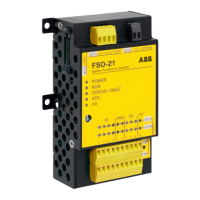172 Safety functions
Variable Safely-limited speed (SLS)
This safety function requires that FSO communicates with a safety-capable PLC via
PROFIsafe over PROFINET. For more information, see chapter PROFIsafe.
The SLS function prevents the motor from exceeding user-defined speed limits. With
the Variable SLS function, the speed limits are scaled with a safety PLC via
PROFIsafe bus and can be changed on the fly.
If the motor speed reaches the SLS trip limit, the FSO module activates the SSE
function (see section SLS trip limit hits on page 167). If the motor speed reaches a
ramp monitoring limit during deceleration, the FSO module activates the STO
function. With time monitoring, the FSO module starts to monitor motor speed after
SLS time delay has elapsed, and if the speed is above the SLS trip limit, the FSO
activates the SSE function.
The SLS function with fixed limits and the SMS function can be active at the same
time with the Variable SLS function. In this case, the FSO module limits the motor
speed according to the lowest speed limit.
The safety PLC sends the Variable SLS request to the FSO module in a PROFIsafe
message. The message includes a scaling value as a percentage (%). The scaling
value is used to scale the original SLS and trip limits (SLS4 parameters) to new,
scaled values. The FSO module uses these scaled values until a new scaling value is
received from the safety PLC.
The Variable SLS limits cannot be scaled above the SLS4 limits.
In the PROFIsafe message, the bits that are used to configure the Variable SLS
function are:
• Positive_Scaling: defines whether the positive SLS limits are scaled or not.
• Negative_Scaling: defines whether the negative SLS limits are scaled or not.
• Variable_SLS_limit (MSB and LSB): defines the scaling value. For example, if the
value set in Variable_SLS_limit = 5000, the scaling value is 50%.
Note: Do not add a plus or a minus sign (+ / -) in front of the scaling value for the
Variable_SLS_limit. Use a scaling value smaller than 100.
The same scaling value is applied to both the positive and the negative limits. For
more information, see section ABB_PS1 profile F-Output user data on page 202.
For more information on how the FSO module defines the scaled limits, see section
Defining the scaled SLS4 limit and SLS4 trip limits on page 370.
For more information on drive modulation loss during SLS deceleration ramp, see
SLS reaction when modulation is lost during deceleration ramp, with ramp monitoring
on page 147 and SLS reaction when modulation is lost during deceleration ramp, with
time monitoring on page 157.

